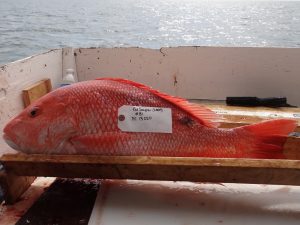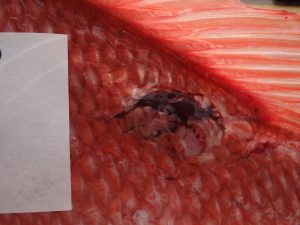Study Finds Concurrent Rise and Fall of Fish Lesions and Oil Contamination
– August 28, 2014
Florida scientists analyzed over 7,400 Gulf of Mexico fish representing 103 species for skin lesions after fishermen reported diseased fish after the Deepwater Horizon oil spill.
After excluding other potential causes for the lesions, researchers have concluded that oil-related contamination due to the Macondo accident may be the cause. Furthermore, the oil residue in affected fish liver most closely matched the Macondo oil chemical signature as compared with other sources of oil pollution entering the Gulf. Fish caught between 2011 and 2012 experienced a substantial drop in lesion frequency and severity, which coincided with a similar drop in polycyclic aromatic hydrocarbon (PAH) metabolites found in fish bile. This suggests that exposure to an elevated hydrocarbon source during 2010 – 2011 is consistent with the increase in fish lesions, while the subsequent decline in hydrocarbon led to their decrease. The researchers published their findings in the July 2014 issue of Transactions of the American Fisheries Society: Prevalence of external skin lesions and polycyclic aromatic hydrocarbon concentrations in Gulf of Mexico fishes, post-Deepwater Horizon.
Open skin lesions in fish, which are relatively rare in offshore marine fishes, can be influenced by multiple environmental stressors, such as wounds from predators, pathogens, reduced salinity, and contaminants. Gulf fish are chronically exposed to, but can efficiently metabolize, oil contaminants from natural seafloor seeps and anthropogenic sources. Past studies estimate that the average annual input of oil into the Gulf is about 96,000 tons. Oil in the Gulf increased to nearly 700,000 tons after the Deepwater Horizon blowout. In the following winter, fishermen persistently reported lesions in offshore fish, raising concerns that the spill was the cause. This study’s goal was to document the frequency and spatial distribution of fish with skin lesions, the level of hydrocarbons in the fish sampled, and the potential source of those hydrocarbons.
In 2011, the team collected over 3,000 fish from 84 sites in oiled and non-oiled areas. They returned in 2012, collecting over 3,400 fish from some original sites and additional sites in areas farther west that had existing oil production, but no evidence of Macondo oil. The majority of their overall catch included Red Snapper, Red Grouper, Gulf Smoothhound, Atlantic Sharpnose Shark, King Snake Eel, and Tilefish.
Researchers examined all fish for external skin lesions (ulcers or other eruptions, skin irritations unrelated to mechanical damage); fin rot disease; parasites or tumors on the gills; recent mechanical damage (trauma from the catching process or predators); and other tumors/tumor-like growths on the skin and internal organs. The status of each lesion was evaluated and identified as either an open bloody ulcer, closed skin contusion, healing, or old injury. For Red Snapper and associated species, they extracted muscle, liver, and bile samples. Muscle and liver tissue were analyzed using gas chromatography-mass spectrometry, which detects individual PAH compounds at low levels. Bile was analyzed using a high-performance liquid chromatography-fluorenscence method, which determines concentrations of classes of PAH metabolites.
In 2011 sampling, there was a “consistent, relatively high frequency” of skin lesions in some bottom-dwelling species along the continental shelf edge north of the oil spill site; the concentrations of PAHs in liver and muscle were “relatively low” and well below U.S. Food and Drug Administration consumption levels of concern; and there were “relatively high concentrations” of PAH metabolites in bile. By 2012, the overall frequency of lesions in fishes in the vicinity of the Deepwater Horizon had declined 53%, with severity also declining. At the same time, PAH levels in bile were declining by an equivalent percentage.
The average composition of PAHs in Red Snapper liver was “highly correlated with oil collected at the Deepwater Horizon wellhead,” despite the nearly one year that elapsed between the end of the spill and sampling, and was “less coherent with other PAH sources” such as natural oil seeps and inputs from rivers in the northern Gulf. The team also ruled out oceanic condition stressors as the cause of lesions by comparing their incidence to recorded salinity and temperature anomalies in the Gulf in 2010 – 2011.
These results led the team to conclude that the lesions were likely caused by an episodic contaminant exposure rather than chronic exposure, though they could not definitively name Macondo oil as the source. “We cannot say with 100 percent certainty that it was the Deepwater Horizon oil spill, but we can say what it was not,” said Steven Murawski, marine science professor at the University of South Florida and lead author of this study, “And what it was not was basically everything else we were capable of analyzing.”
The study’s authors are Steven A. Murawski, William T. Hogarth, Ernst B. Peebles, and Luiz Barbieri.
This research was made possible in part by a grant from BP/The Gulf of Mexico Research Initiative (GoMRI) to the Center for Integrated Modeling and Analysis of Gulf Ecosystems (C-IMAGE). Other funding sources included the National Marine Fisheries Service (NA11NMF4720151– Systematic Survey of Fish Diseases in the Gulf of Mexico to S.A.M. and W.T.H.); the National Oceanic and Atmospheric Administration; and the State of Louisiana.
The GoMRI is a 10-year independent research program established to study the effect, and the potential associated impact, of hydrocarbon releases on the environment and public health, as well as to develop improved spill mitigation, oil detection, characterization and remediation technologies. An independent and academic 20-member Research Board makes the funding and research direction decisions to ensure the intellectual quality, effectiveness and academic independence of the GoMRI research. All research data, findings and publications will be made publicly available. The program was established through a $500 million financial commitment from BP. For more information, visit https://gulfresearchinitiative.org/.
© Copyright 2010- 2017 Gulf of Mexico Research Initiative (GoMRI) – All Rights Reserved. Redistribution is encouraged with acknowledgement to the Gulf of Mexico Research Initiative (GoMRI). Please credit images and/or videos as done in each article. Questions? Contact web-content editor Nilde “Maggie” Dannreuther, Northern Gulf Institute, Mississippi State University (maggied@ngi.msstate.edu).







